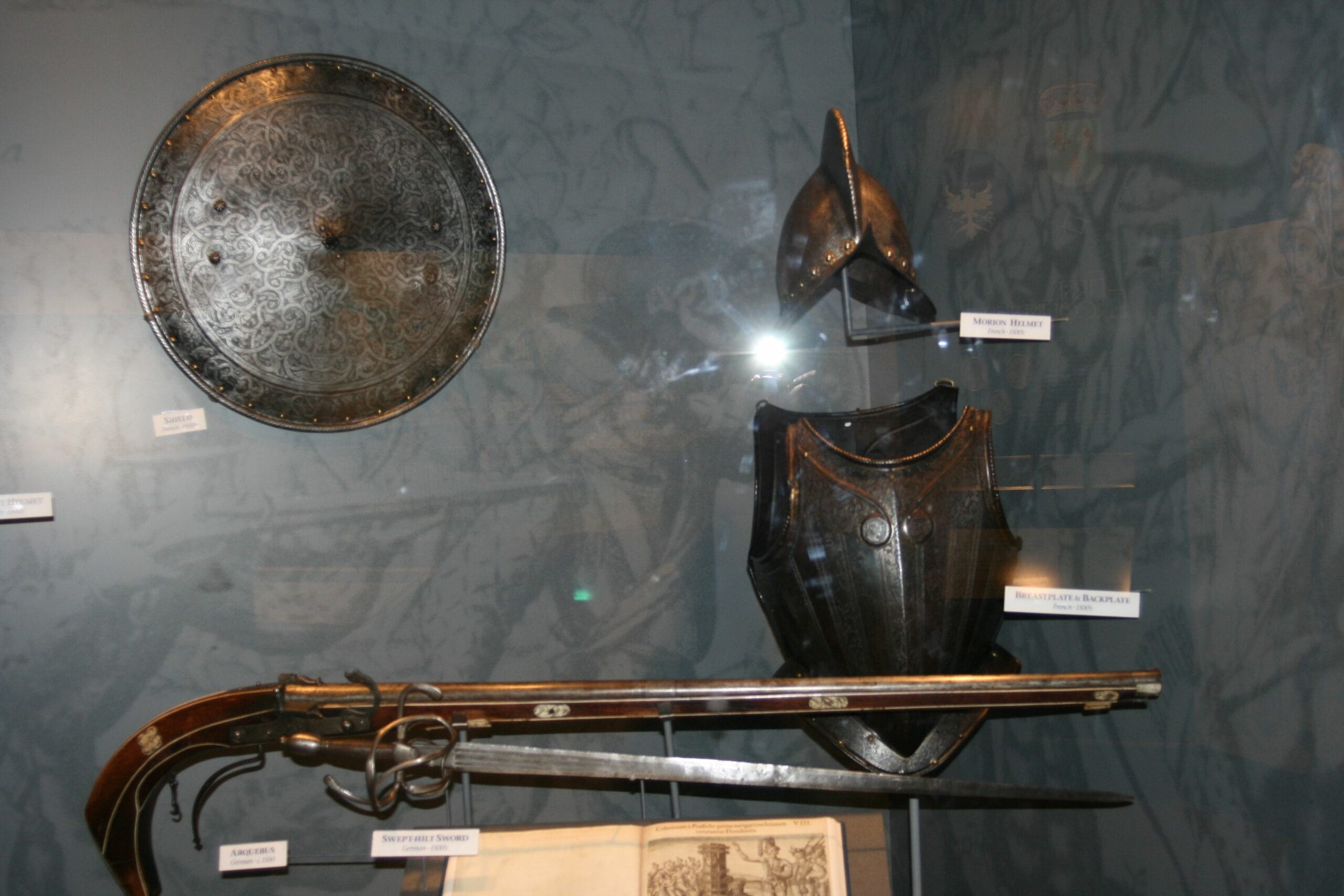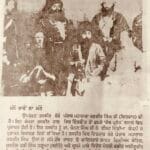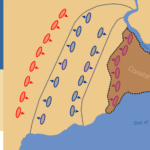Conquistadors, the intrepid warriors who carved out vast empires in the heart of the New World, were renowned for their unwavering courage, ruthless ambition, and of course, their formidable armor. More than just protection, their helmets, breastplates, and intricate limb defenses served as a symbol of Spanish military might and a decisive factor in their conquests. This exploration delves into the historical significance of conquistador armor, uncovering its craftsmanship, evolution, and enduring impact on the clash of cultures in the Americas.
Forged in Toledo, Tested in the Americas: The Significance of Conquistador Armor
Imagine the 16th century, a time when the Americas whispered tales of untold riches and uncharted territories. The Spanish conquistadors, driven by a potent mix of gold, glory, and religious fervor, embarked on daring expeditions to claim these new lands for the Spanish crown. Their success, however, hinged on more than just their ambition; it depended heavily on the technological superiority their armor provided.
Crafted in the fiery heart of Toledo, Spain, renowned for its master swordsmiths and superior metallurgy, conquistador armor represented the pinnacle of 16th-century craftsmanship. This wasn’t simply protection; it was a meticulously engineered system designed to withstand the very real dangers of the New World. The most iconic piece, the Morion helmet with its distinctive crest, became a symbol of Spanish military power, striking awe, and apprehension into the hearts of those who opposed them. Its presence, amplified by the weight and imposing nature of the full armor, undoubtedly provided a psychological edge, tipping the scales in favor of the Spanish.
Anatomy of Conquest: Deconstructing Conquistador Armor
To truly understand the impact of conquistador armor, we must dissect its individual components, each meticulously crafted to provide maximum protection without sacrificing mobility:
- Morion Helmet: This now-iconic helmet, adopted widely after the conquests of Mexico and Peru, offered crucial head protection with its high crest and wide brim, deflecting blows from both blades and projectiles. Its adoption by other European armies in later years speaks volumes about its effectiveness and iconic status.
- Cuirass Breastplate: This essential piece shielded the conquistador’s torso, consisting of a breastplate and backplate, often forged from a single sheet of steel. The cuirass provided a robust defense against most indigenous weapons and even offered some protection against early firearms.
- Limb Defenses: Recognizing that a warrior is vulnerable without full-body protection, conquistadors also donned arm and leg defenses: cuisses for the thighs, poleyns for the knees, and greaves for the shins and calves. These additions further contributed to their advantage, as full-body armor was less common among indigenous populations.
This meticulously crafted armor, however, came at a cost. The weight, particularly in the humid, tropical climates of the Americas, could be debilitating, potentially leading to exhaustion, heatstroke, and other health issues. Yet, the protection it offered against unfamiliar weapons and tactics outweighed these drawbacks, playing a key role in the Spanish conquest of the New World.
A Clash of Technologies: Steel Against Indigenous Weaponry
The arrival of conquistadors in the Americas marked a significant clash of technologies. While indigenous populations demonstrated incredible ingenuity in their own right, their weapons, primarily obsidian-based, along with wooden clubs and maces, proved less effective against the superior metallurgy of Spanish steel.
Perhaps the most striking example of this technological disparity lies in the contrast between conquistador armor and the Mesoamerican Ichcahuipilli. This defensive garment, crafted from densely packed cotton layers often soaked in salt brine for added rigidity, offered surprising resilience against arrows and even some early firearms. However, it proved less effective against the piercing power of Spanish steel blades.
Beyond the Battlefield: Armor’s Enduring Legacy
The legacy of conquistador armor extends far beyond the battlefields of the New World. It serves as a tangible reminder of a pivotal period in history, a symbol of the technological disparities that fueled conquest, and a testament to the craftsmanship of a bygone era.
However, it’s crucial to acknowledge that our understanding of conquistador armor continues to evolve. Historians and archaeologists are constantly unearthing new evidence, reinterpreting existing data, and engaging in debates about the finer details of its construction, effectiveness, and impact on both Spanish soldiers and the indigenous populations they encountered.
Further areas of exploration include:
- The cultural significance of armor in 16th-century Spain.
- Myths and misconceptions surrounding the weight, flexibility, and overall effectiveness of conquistador armor.
- The human cost of wearing such heavy armor in challenging climates and terrain.
By delving deeper into these nuances, we can gain a more comprehensive and nuanced understanding of the role conquistador armor played in shaping the course of history.
What Kind of Armor Did Conquistadors Wear?
Imagine yourself as a Spanish conquistador in the 16th century, stepping onto the shores of a world unknown. The air hums with the sounds of unfamiliar creatures, the scent of exotic plants fills your nostrils, and before you lie dense jungles and towering mountains, promising both riches and danger. In this unpredictable environment, your armor wasn’t just a piece of equipment; it was a lifeline, a symbol of your place in the expedition, and a testament to the technological prowess of Spain.
Not all conquistadors, however, were outfitted equally. Wealth played a significant role in determining the quality and quantity of armor one possessed. A wealthy conquistador, perhaps a high-ranking officer, could likely afford the luxury of a full suit of plate armor, a shining beacon of steel that signified status and provided maximum protection against the unknown threats they might encounter. This elite class of conquistadors, clad head-to-toe in articulated plates of steel, must have presented an intimidating sight, their armor clanking with each step, announcing their arrival as a force to be reckoned with.
For the average foot soldier, however, practicality often trumped extravagance. These conquistadors, the backbone of the Spanish forces, relied on a more practical, albeit less glamorous, assortment of armor pieces, strategically chosen to balance protection with mobility. Think of it as the difference between a knight charging into battle on horseback and a soldier skillfully navigating the dense undergrowth on foot – both require protection, but their choices reflect their role and resources.
So, what were these essential pieces of armor that safeguarded the lives of these conquistadors?
The cuirass, a sturdy breastplate typically crafted from iron or steel, was paramount. This vital piece acted as a shield for the torso, guarding the heart and lungs from potentially fatal wounds. Next came the helmet, a crucial element in a conquistador’s defense. The iconic Morion, with its distinctive crest that seemed to reach for the heavens, became a symbol of the era, but conquistadors also relied on other helmets like the Salade, which provided more complete facial protection, a crucial consideration in the heat of battle.
But protection didn’t stop at the torso and head. Conquistadors also shielded their legs with tasses, metal plates strategically placed to protect their thighs. Hands and arms, vital for wielding swords and firearms, were safeguarded by gauntlets, essentially armored gloves, and vambraces, which shielded the forearms. And to deflect blows aimed at the shoulders, they donned pauldrons, because, let’s face it, no one wants to end their conquest with a spear to the shoulder.
Now, you might be asking yourself, “Iron and steel in the Americas? Wouldn’t that be incredibly heavy and unbearably hot, especially in the tropical climates they encountered?”.
You’re absolutely right! Wearing heavy armor in such demanding conditions must have been incredibly uncomfortable. However, this discomfort was a small price to pay for the significant advantage these materials provided. Iron and steel, far superior to the materials used by many indigenous populations, gave the conquistadors a distinct edge. Their weapons, often crafted from obsidian, wood, or bone, simply couldn’t match the strength and resilience of Spanish steel.
This disparity in technology played a pivotal role in shaping the outcome of many confrontations. The conquistadors’ armor enabled them to withstand attacks that would have decimated less-equipped forces, allowing them to push forward, conquer new territories, and ultimately establish a foothold in the Americas. It serves as a stark reminder that technology, even in its most rudimentary forms, can profoundly influence the course of history.
It’s essential to remember, however, that while we can speak with some certainty about the general types of armor and materials used, many details remain shrouded in the mists of time. The exact effectiveness of specific armor pieces, the variations in construction techniques, and the adaptations made by individual conquistadors in response to the unique challenges of the New World are still being researched and debated by historians today.
New discoveries and interpretations continuously add to our understanding of conquistador armor and its role in shaping the narrative of the conquest of the Americas. This ongoing exploration highlights the dynamic nature of historical inquiry, as we strive to piece together a more complete and nuanced picture of the past.
What Are Conquistador Helmets Called?
When you envision a conquistador, what’s the first image that springs to mind? It’s likely that imposing helmet, isn’t it? The one that seems to embody the spirit of exploration, conquest, and the clash of civilizations. That iconic helmet, the one most synonymous with the conquistadors, is known as the Morion.
Picture this: a tall, almost comically pronounced crest running down the center of the helmet, giving it an air of both grandeur and intimidation. The wide brim curves upward at the sides, like eyebrows raised in a gesture of surprise or perhaps defiance, and the entire helmet is crafted from sturdy, gleaming steel. The Morion, more than just a helmet, became a symbol – a potent representation of Spanish military might.
While the Morion might reign supreme in the popular imagination, conquistadors utilized other helmets as well, each chosen for its specific protective qualities. One such helmet was the Salade, a more practical, less ostentatious helmet favored by infantry soldiers. The Salade provided more comprehensive facial coverage than the Morion, a crucial consideration for soldiers engaged in close-quarters combat where a well-aimed blow to the face could prove fatal.
The Morion truly hit its stride in the mid-1500s, following the successful conquests of Mexico and Peru. Its popularity stemmed not only from its effectiveness in battle but also from its relative affordability and the unmistakable statement it made. Imagine the glint of sunlight reflecting off rows of Morion helmets as conquistadors marched through a newly conquered city — a powerful symbol of Spanish dominance. The Morion’s iconic status transcended geographical boundaries, eventually becoming a popular choice for soldiers across Europe.
So, while the Morion might steal the show when we think about conquistador helmets, it’s crucial to remember that these historical figures utilized a variety of protective headgear. Each helmet, whether a Morion or a Salade, served a specific purpose, reflecting the diverse challenges faced and the ever-evolving tactics employed by these intrepid explorers and conquerors.
Did Conquistadors Use Shields?
Contrary to what some might believe, conquistadors weren’t averse to using shields. In fact, they incorporated shields into their arsenal, favoring a particular type known as a buckler. Imagine a small, circular shield, perhaps similar in size and shape to those used by the legendary Robin Hood and his Merry Men. That’s the buckler – compact, maneuverable, and surprisingly effective.
Most bucklers were fashioned from sturdy steel, although some were crafted from wood and then covered in leather for added durability. But why were bucklers so popular among conquistadors exploring and conquering a new world?
Picture yourself hacking your way through a dense jungle, the air thick with humidity, or traversing treacherous mountain passes. Carrying a large, cumbersome shield would be more of a hindrance than a help, wouldn’t it? That’s where the buckler’s compact size and lightweight design proved invaluable.
Bucklers were perfect for the type of exploration and warfare the conquistadors engaged in. Their agility and maneuverability permitted conquistadors to move swiftly, reacting quickly to unexpected attacks – a crucial advantage in the often-unpredictable encounters they faced in the Americas.
Don’t let their small size fool you; bucklers were more effective than they might appear. They were particularly well-suited for close-quarters combat, where swords clashed and fortunes could change in an instant. In such scenarios, a buckler offered just the right amount of protection, deflecting blows aimed at the chest and vital organs while leaving the conquistador’s sword arm free to counter-attack.
These versatile shields could block attacks from a surprising variety of weapons, from clubs and maces to arrows launched from the cover of the jungle. This defensive flexibility was crucial when facing indigenous warriors who employed a diverse range of fighting styles and weaponry.
Now, you might be wondering, why not opt for a larger shield that provided more coverage? While it’s true that larger shields offered greater protection from a wider range of attacks, they were also heavier and significantly bulkier. The conquistadors, often operating in challenging terrain, needed to be light on their feet, and a large, unwieldy shield would have hampered their mobility. Their tactics often relied on speed, agility, and the element of surprise, and a cumbersome shield would have been a liability.
This isn’t to say that conquistadors never used larger shields, just that they weren’t as common or practical for the type of warfare they waged in the Americas. In some instances, conquistadors might have utilized shields made from layers of hardened leather. While these wouldn’t offer the same level of protection as a steel buckler, they were even lighter and still provided a decent defense against certain weapons.
It’s also important to consider that not all conquistadors were fortunate enough to possess full suits of armor. Full plate armor, a symbol of wealth and status, was expensive to produce and transport, putting it out of reach for many, especially the rank-and-file soldiers who made up the bulk of the Spanish forces. Additionally, wearing heavy armor in the hot, humid climate of much of the Americas would have been not only uncomfortable but also potentially dangerous, increasing the risk of heat exhaustion and other health issues. For those conquistadors who couldn’t afford or didn’t wear full armor, shields became even more critical for their survival.
Interestingly, the conquistadors’ use of bucklers had an unexpected impact on the indigenous populations they encountered. After witnessing the effectiveness of these small, agile shields, particularly in close-quarters combat, some indigenous tribes began incorporating similar shields into their own arsenals. It’s a testament to the adaptability of both sides, as they observed, learned, and adapted their tactics and equipment in response to the ever-changing dynamics of the battlefield.
To summarize the key takeaways about conquistador shields:
- Conquistadors favored the buckler – a small, circular shield that proved lightweight, agile, and surprisingly effective in close-quarters combat.
- While other shield types might have been used occasionally, bucklers were the preferred choice for their practicality and suitability to the type of warfare waged in the Americas.
- The adoption of buckler-style shields by some indigenous tribes highlights how effective these shields proved to be in the conflicts of the time.
The study of conquistador equipment, including their shields, offers a fascinating glimpse into the past, shedding light on how these explorers and conquerors adapted to new challenges, adopted new technologies, and ultimately left their mark on history.
As historians continue to unearth new evidence, analyze existing data, and engage in scholarly debates, our understanding of conquistador armor and its role in shaping the narrative of the conquest of the Americas continues to evolve. Each new discovery, each reinterpretation of existing information, brings us one step closer to a more complete and nuanced understanding of this pivotal period in history.
Internal Links
Discover the depths of Derinkuyu’s hidden underground city by navigating the Derinkuyu underground city map. Escape into the world of cinema with Dreamland Cinema Nantucket, where dreams become reality on the silver screen.
- Unlock what part of speech is is: Master English Grammar Now - April 2, 2025
- Unlock the best US history books: A curated list for insightful reading - April 2, 2025
- First Lady Book: A History of Power and Influence - April 2, 2025
















